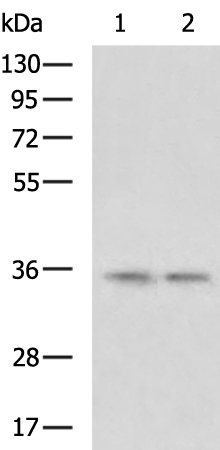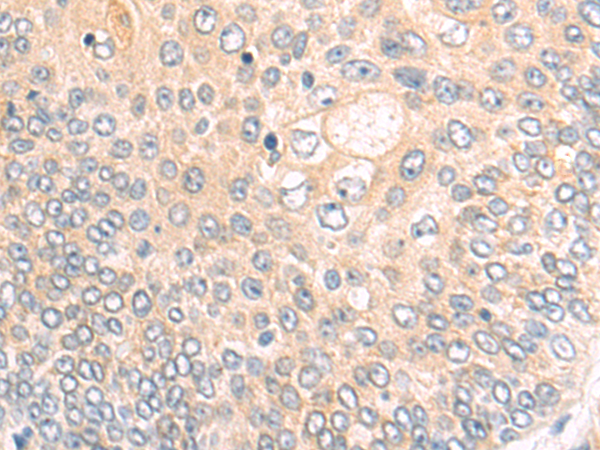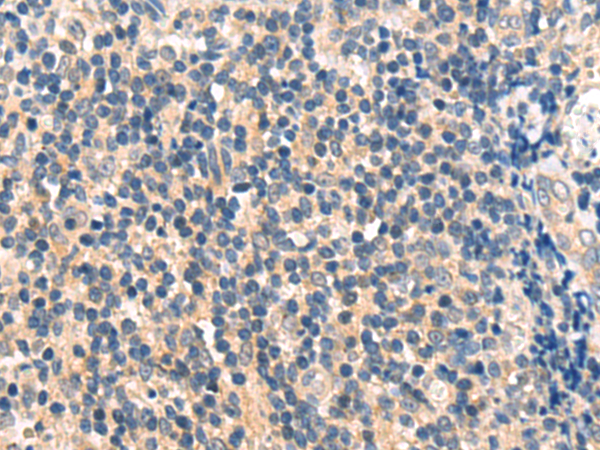


| WB | 咨询技术 | Human,Mouse,Rat |
| IF | 咨询技术 | Human,Mouse,Rat |
| IHC | 1/50-1/200 | Human,Mouse,Rat |
| ICC | 技术咨询 | Human,Mouse,Rat |
| FCM | 咨询技术 | Human,Mouse,Rat |
| Elisa | 1/5000-1/10000 | Human,Mouse,Rat |
| Aliases | Txl; TXNL; TRP32; TXL-1; HEL-S-114 |
| WB Predicted band size | 32 kDa |
| Host/Isotype | Rabbit IgG |
| Antibody Type | Primary antibody |
| Storage | Store at 4°C short term. Aliquot and store at -20°C long term. Avoid freeze/thaw cycles. |
| Species Reactivity | Human, Mouse, Rat |
| Immunogen | Fusion protein of human TXNL1 |
| Formulation | Purified antibody in PBS with 0.05% sodium azide and 50% glycerol. |
+ +
以下是3篇涉及TXNL1抗体的参考文献摘要信息,基于公开文献整理:
---
1. **文献名称**:*Thioredoxin-like protein 1 (TXNL1) regulates cisplatin resistance through autophagy in ovarian cancer*
**作者**:Chen Y, et al.
**摘要**:研究利用TXNL1特异性抗体进行Western blot和免疫组化分析,发现TXNL1在卵巢癌顺铂耐药细胞中高表达,并通过调控自噬途径影响化疗敏感性。
---
2. **文献名称**:*TXNL1 as a novel redox regulator in hepatocellular carcinoma progression*
**作者**:Wang L, et al.
**摘要**:通过抗TXNL1抗体的免疫荧光染色,揭示了TXNL1在肝癌细胞核内的定位异常,并证实其通过调节氧化应激信号促进肿瘤侵袭性。
---
3. **文献名称**:*Development of a polyclonal antibody against human TXNL1 and its application in protein interaction studies*
**作者**:Zhang R, et al.
**摘要**:本研究报道了一种针对人源TXNL1的多克隆抗体制备方法,验证了抗体在免疫共沉淀(Co-IP)中的有效性,用于鉴定TXNL1与p53蛋白的相互作用。
---
如需具体文献来源或DOI,建议通过PubMed或SciHub等平台按标题或作者检索获取。
The TXNL1 antibody is a research tool designed to detect thioredoxin-like protein 1 (TXNL1), a member of the thioredoxin family involved in redox regulation. TXNL1. also known as TRP32 or TXNDC5. contains a conserved thioredoxin domain with a CXXC active site motif, enabling its participation in disulfide bond reduction and cellular antioxidant defense. It plays roles in protein folding, apoptosis regulation, and cellular stress responses, with implications in cancer, neurodegenerative disorders, and oxidative stress-related pathologies.
TXNL1 antibodies are typically developed in hosts like rabbits or mice using immunogenic peptides or recombinant TXNL1 proteins. These antibodies enable the identification and quantification of TXNL1 in techniques such as Western blotting, immunohistochemistry (IHC), and immunofluorescence (IF). Validation often includes testing specificity via knockout/knockdown controls and assessing cross-reactivity across species (e.g., human, mouse, rat).
Research using TXNL1 antibodies has elucidated its overexpression in certain cancers, where it may promote tumor survival by mitigating oxidative damage, and its downregulation in neurodegenerative conditions linked to protein misfolding. Commercial antibodies vary in clonal type (monoclonal/polyclonal), conjugation (e.g., HRP, fluorescent tags), and applications, requiring careful selection based on experimental needs. Proper controls are essential to ensure accurate interpretation in redox-sensitive studies.
×